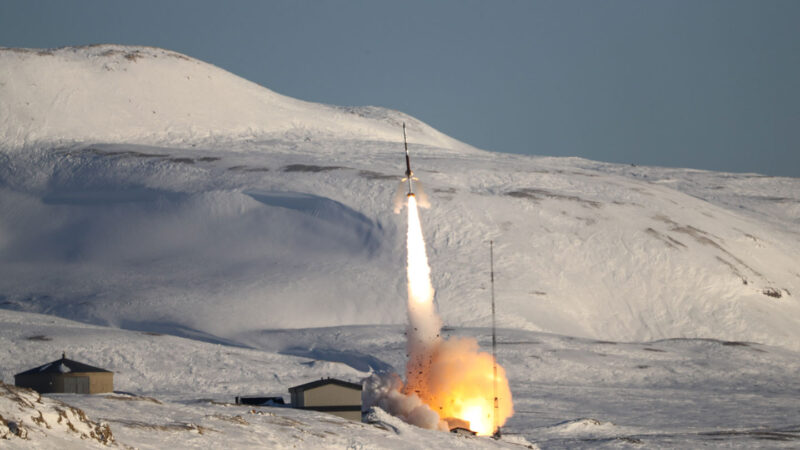For the first time, scientists have measured a long-sought global electric field in Earth’s atmosphere. This ambipolar electric field had been predicted to exist decades ago. But it had never been detected — until now.
“That’s the big whoop,” says Glyn Collinson. He works at NASA’s Goddard Space Flight Center in Greenbelt, Md. An atmospheric scientist, he was lead investigator for the Endurance rocket program. And what it’s just detected, he says, is “a whole frickin’ new planetary-energy field that’s never been measured before!”
Explainer: Our atmosphere — layer by layer
The field is weak. At only 0.55 volt, it’s about as strong as a watch battery, Collinson says. Still, that’s strong enough to control the shape and evolution of Earth’s upper atmosphere. And the features it controls, he says, could affect the suitability of our planet for life.
“It’s fundamental to the DNA of our planet,” Collinson says of this field. He led a team that confirmed its presence in the August 28 Nature.
Learn more about this newfound third major “field” that not only shapes the environment of our planet but also helps make it habitable. Though very weak, this electric field can still lift the atmosphere up and allow for a hitherto mysterious up-flowing polar wind.
What they were looking for — and why
Scientists first predicted such an electric field in the 1960s. This was at the dawn of the space age. Early spacecraft flying over Earth’s poles detected a supersonic outflow of ions — charged particles — exiting the atmosphere. They called it a polar wind.
The most reasonable thing to explain that speedy wind would be some electric field. How? Sunlight might kick electrons out of atoms in the upper atmosphere. Those negatively charged electrons are energetic and light enough that they want to float out into space. Left behind are positively charged oxygen ions. Being heavier, they want to sink down in Earth’s gravity.
Explainer: Ions and radicals in our world
But the atmosphere wants to remain electrically neutral — neither positive nor negative — by keeping an equal balance between electrons and positive ions. So this electric field forms. It keeps the electrons tied to the ions, which prevents them from escaping.
Once established, the field can act as a booster for lighter ions, such as hydrogen. It gives them enough energy to break free of Earth’s gravity. Now they zoom away, forming that polar wind. The field also pulls heavier ions higher up into the atmosphere than they would otherwise reach. Here, other forces can propel them, too, into space.
That was the hypothesis, anyway. But until very recently, technology to detect that field didn’t exist.
Being such a weak field, Collinson says, finding it “was genuinely thought impossible.”
See how the ambipolar electric field works in this short animation. Nitrogen gas (N2) is the most abundant gas in Earth’s lower atmosphere (where we live). It’s shown around seven seconds in. Pan up to the ionosphere (14 seconds in), though, and you’ll find more atomic oxygen (O2). Light photons from the sun can collide with oxygen atoms and knock one of their electrons loose. A positively charged ion remains. The pull between those ions and their lost electrons is the ambipolar electric field, which ties them together.
Challenging trek toward the top of the world
Collinson was part of a team that tried to measure a similar field on Venus. For comparison, they looked for any paper that would give them the strength of Earth’s field. But there wasn’t one.
“Turned out, funny story, it’s never been done,” he recalls. “We were like, ‘Game on!’”
He and his team had to develop a new instrument to measure it. They mounted this photoelectron spectrometer onto a rocket. They called the rocket Endurance. They named it for the ship that Ernest Shackleton’s team took to explore Antarctica in 1914.
Glyn Collinson checks his team’s new photoelectron spectrometer as the rocket that will launch it is being assembled in Svalbard, Norway. The device detected a weak electric field, which develops in the atmosphere above Earth’s poles.
Getting to the launchpad was a journey worthy of the rocket’s name. They had to be as far into the polar region as possible. So the team traveled by boat for 17 hours to get to a Norwegian archipelago. Known as Svalbard, it’s just 1,300 kilometers (815 miles) from the North Pole.
Along the way, several members of the team got sick with COVID-19. Adding to tensions, the war between nearby Russia and Ukraine had begun just a few months earlier.
So that explains “a certain amount of nervousness about firing off rockets,” Collinson recalls. “Polar bears were the least of it. We had war and plague.”
Two more days of blizzards kept Endurance grounded. When the rocket finally launched on May 11, 2022, it went straight up through the atmosphere to a height of around 770 kilometers (480 miles). Along the way, it measured the energies of electrons every 10 seconds. The flight lasted 19 minutes. Afterward, the rocket fell back to Earth, splashing down in the Greenland Sea.
And then … eureka!
Between 248 and 768 kilometers up, Endurance detected a change in the electric potential of 0.55 volt. That’s not much. But it was exactly enough to explain the polar wind.
The measurement is solid and exciting, says David Brain. A planetary scientist, he works at the University of Colorado Boulder and did not take part in the new work. He also cautions that it’s only one data point and from just one rocket. “This result is a really great result,” he says, but one that “argues there should be more measurements like this.”
Collinson agrees. NASA recently approved his team to launch a follow-up rocket. It will be named Resolute for an Arctic-exploring ship that set sail in 1850.
The ambipolar electric field helps control how quickly a planet’s atmosphere escapes into space. As such, it likely plays some role in making a planet hospitable to life, Collinson says.
Like Earth, the Venusian atmosphere has an electric field. But it’s far stronger than Earth’s and led to a far different evolution of its climate, as this animation explains.
The field’s good — and not-so-good — impacts
Both Mars and Venus also have electric fields. But in their cases, they might have fared better over time without them.
For instance, Mars used to be more like Earth, scientists think. Over time, it lost much of its atmosphere to space. Indeed, that atmospheric “loss to space was a significant, if not dominant, process in changing [Mars’] climate,” Bruce Jakosky told Science News back in 2015. Jakosky, who works at the University of Colorado Boulder, led a team that measured that loss. And Venus used to be much wetter, data suggest.
If such an electric field didn’t exist on Venus and Mars, “then I think it’s possible Venus and Mars would have lost less oxygen,” Brain says — and therefore less water.
Earth’s ambipolar electric field helps kick its oxygen out into space, too. But Earth has one key advantage over Mars and Venus: It has a global magnetic field to guide charged particles around the planet.
Within the solar system, Venus appears to have started out as Earth’s twin. But owing to a very different electric-field strength, Venus lost most water from its surface and atmosphere. Today, Venus is a very hot, dry place, while our planet is a relatively comfortable site teeming with life.Brian Monroe/Conceptual Image Lab/Goddard/NASA; adapted by L. Steenblik Hwang
“The electric field is the engine that gets the particles moving,” Brain explains. “The magnetic field is sort of the road that the particles move along.” Earth’s magnetic field means oxygen can escape only near the poles, rather than from any or all parts of the atmosphere.
And that, he adds, could help explain why Earth has kept its habitable atmosphere for so much longer than Venus or Mars.
“Fundamentally, what makes a planet habitable is going to be many things,” Collinson says. “But I think comparing these different energy fields across different planets is a way to answer the question: Why is the Earth habitable?” In other words, “Why are we here?”
Do you have a science question? We can help!
Submit your question here, and we might answer it an upcoming issue of Science News Explores





 Arabic
Arabic Chinese (Simplified)
Chinese (Simplified) English
English French
French German
German Italian
Italian Japanese
Japanese Russian
Russian Sinhala
Sinhala Spanish
Spanish Tamil
Tamil